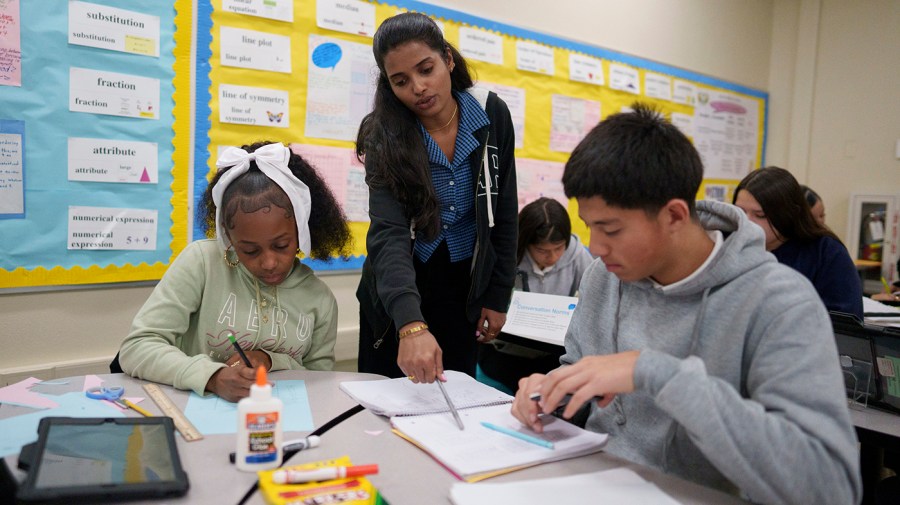The Democratic Party is having to take a hard look at its education strategy as Republicans move aggressively on the issue with satisfaction in public education at its lowest point in decades.
Democrats, who dominated the education realm for years, are on their back foot as President Trump and the GOP look to enact sweeping reforms, including federal about-faces on gender policy, a big push for school choice and potentially eliminating the Education Department.
Strategists say it is time Democrats get back ahead of the issue and get proactive with solutions and more aggressive messaging instead of assuming voters are on their side when it comes to schools.
“The Democrats have definitely lost their advantage on education,” said Jorge Elorza, CEO of Democrats for Education Reform. “Democrats are no longer the party of education, and so, there is a political imperative for them to reprioritize education and to refocus on it now with Donald Trump in office.”
“I think that there is a lot for Democrats to certainly oppose that are parts of his agenda, but I think that opposing and resisting alone is just not sufficient. There is an opportunity for Democrats to own education once again, but it can’t just be opposing whatever the other side proposes, we also have to provide a compelling alternative,” Elorza added.
Trump has come into office swinging on the issue, from calls to close the Department of Education to multiple executive orders that could transform public education.
The president took executive action to help states enact school choice policies, ban the teaching of critical race theory and gender issues in schools, promote “patriotic” education, prohibit transgender children from playing on sports teams that match their gender identity and put more federal resources to combatting antisemitism on college campuses.
“Thanks to President Trump, our service members no longer have to choose between serving our country and their children’s education. Military-connected children are too often assigned to the public schools closest to military bases, regardless of whether those district schools are right for them,” said Lindsey Burke, director of the Heritage Foundation’s Center for Education Policy, after Trump signed a school choice executive order.
These actions are new at the national level, but dozens of Republican-led states have also made moves to advance school choice and ban critical race theory from schools since the pandemic.
Rodell Mollineau, a Democratic strategist, said “the cold reality” is that “the satisfaction decline started with COVID and just hasn’t stopped, and there are many people across demographics that are that are concerned with outcomes.”
“The frustration of a lot of Americans are leading them to look for solutions, and perhaps the ones that they’re grasping at that Republicans are offering aren’t going to solve the problems, but it’s the only thing that’s out there,” he added.
Years after schools were closed for COVID-19, test scores are still down and behavioral issues are up.
The recent National Assessment of Educational Progress (NAEP) scores showed fourth and eighth graders are still behind in reading and math, and the achievement gap is widening between high performing and low performing students.
The situation has left a gaping hole in what to do as a recent Gallup survey showed dissatisfaction with public education is at 73 percent, the highest since Gallup has begun polling on the issue back in 2001.
“Education always is top of mind for voters, particularly in state and local and gubernatorial races, and it really has taken a back seat in federal races lately, which I think is a problem for Democrats,” said Martha McKenna, a Democratic strategist. “I think we have an opportunity here with Linda McMahon taking over the Department of Education [and] Trump saying he wants to get rid of it altogether.”
“I think that Republicans will totally overreach and screw this up,” McKenna said, predicting that when the Trump administration starts slashing programs at the Department of Education and voters feel the effects, “people will be angry.”
She says Democrats need to be there when those policies start to crash and burn.
“It’s important that we show that Democrats are fighting for schools, and it would be great if those legislators, those members of Congress and others, went back in their districts” to figure out “what’s most important for them and what needs to be protected during what could be a very chaotic four years of the Trump administration,” she added.
The solutions Democrats need to offer are hotly debated, with some arguing it is important voters hear more than just that there needs to be more funding in public schools, a common line used by the party.
During the pandemic, the federal government issued billions of dollars to K-12 schools in one of the largest funding efforts for the institutions in history, but students as still struggling.
“We just can’t continue defending the indefensible. We just saw it with the NAEP results, and we’ve known it for a long time that so many of our schools are just not making the grade, and we need to be serious about holding schools that are failing kids accountable, and that has to be part of the equation. But unfortunately, over the past 10 years, Democrats have certainly moved away from supporting choice and accountability, but that needs to return,” Elorza said.
Elorza argued with the rise of parents looking for options for their students’ schooling, Democrats need to give a viable alternative to how Republicans are offering school choice, one where different public school options are available.
“What we believe is that there needs to be investments to a broad array of education options as so that there are alternatives to the traditional public school system that are available to families, such as public charter schools and we also need accountability,” he added.
